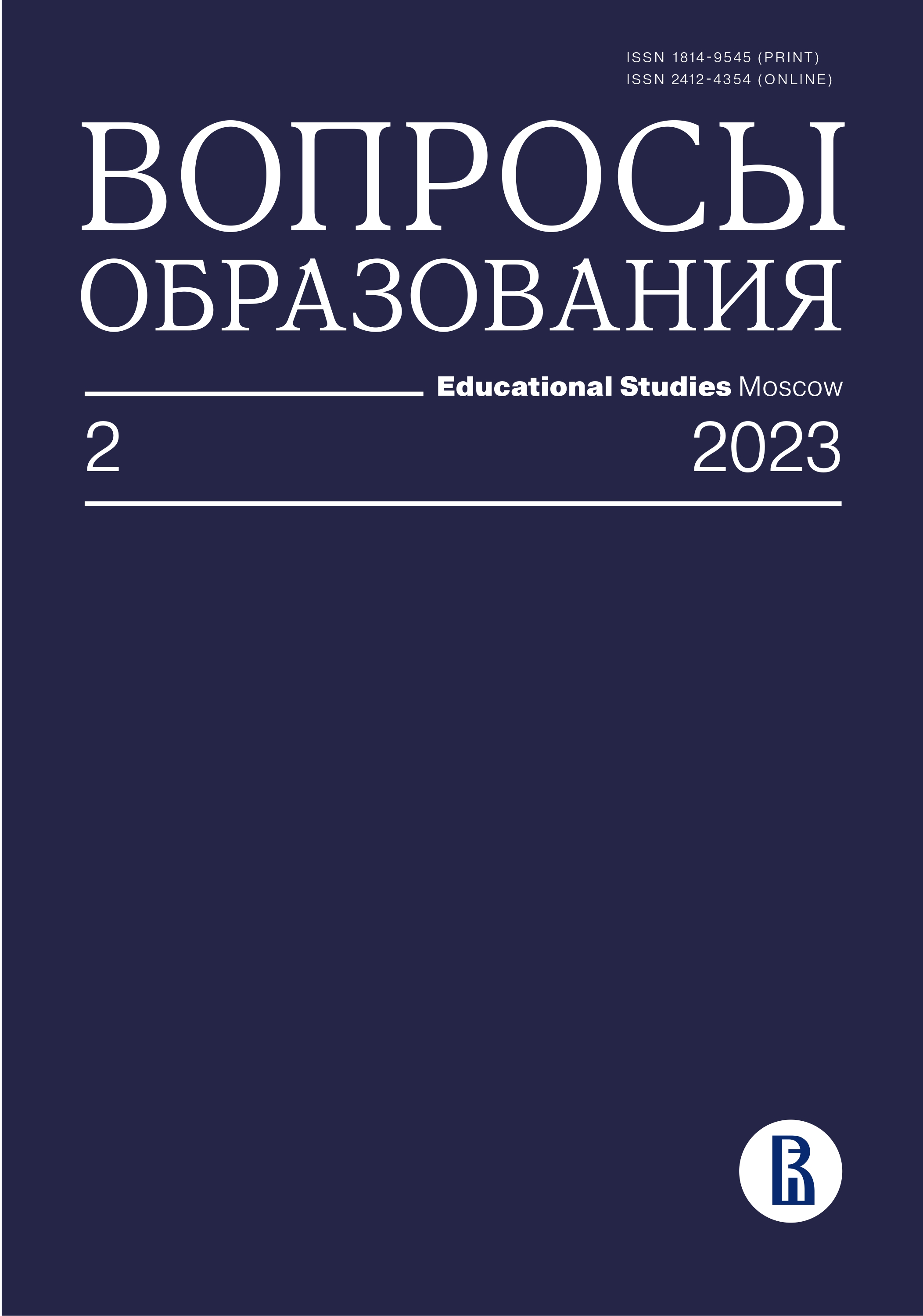Urban Literacy and How to Measure It
Abstract
In the studies of the last decade, the word "literacy" is one of the most commonly used, one might even say pedagogically fashionable. A number of significant areas of literacy study concretize the concept of "literacy" through the concepts of "space" and "practice", focusing on tools and resources involved with specific goals in a specific space (social, educational, cultural, etc.). Justifying the need to highlight urban literacy, the authors of the article proceed from the premise that the study of this new type of literacy is possible by combining spatial (where literacy is formed and why it goes beyond the school classroom) and practical (how literacy manifests itself and what knowledge and experience it requires) coordinates. The article substantiates that urban literacy is based on the complex nature of reading and writing, is firmly connected with the life of citizens of all ages and is of great importance for learning. Urban literacy of adolescents is considered as literacy, which focuses on the search for the optimal way of action in solving problems in the city space related to the movement, consumption and social interaction of adolescents based on the principles of a healthy lifestyle, responsible behavior, personal safety, as well as knowledge of the history and cultural characteristics of the city. This literacy includes the following practices (or components): pro-social engagement practices; healthy lifestyle practices; practices of intercultural interaction; practices of the use of digital technologies; practices of local awareness; practices of mobility in the city. The proposed tool for measuring urban literacy assumes a comprehensive perspective for assessing important aspects of a child's interaction with the city based on authentic realistic scenario-type tasks.
Downloads
References
Barton G. (2013) Don't Call It Literacy! What Every Teacher Needs to Know about Speaking, Listening, Reading and Writing. New York, NY: Routledge. https://doi.org/10.4324/9780203112007
Baynham M., Prinsloo M. (2009) Introduction: The Future of Literacy Studies. The Future of Literacy Studies (eds M. Baynham, M. Prinsloo), Basingstoke: Palgrave Macmillan, pp. 1–20. http://dx.doi.org/10.1057/9780230245693_1
Bochaver A.A., Korzun A.N., Polivanova K.N. (2017) Ulichny dosug detey i podrostkov [Outdoor Pastimes of Children and Teenagers]. Psychology. Journal of the Higher School of Economics, vol. 14, no 3, pp. 470–490. https://doi.org/10.17323/1813-8918-2017-3-470-490
Brandt D. (2009) Writing over Reading: New Directions in Mass Literacy. The Future of Literacy Studies (eds M. Baynham, M. Prinsloo), Basingstoke: Palgrave Macmillan, pp. 54–74. https://doi.org/10.1057/9780230245693_4
Carlson J.A., Saelens B., Kerr J., Schipperijn J. et al. (2015) Association between Neighborhood Walkability and GPS-Measured Walking, Bicycling and Vehicle Time in Adolescents. Health & Place, vol. 32, March, pp. 1–7. http://dx.doi.org/10.1016/j.healthplace.2014.12.008
Chao M.M., Okazaki S., Hong Y. (2011) The Quest for Multicultural Competence: Challenges and Lessons Learned from Clinical and Organizational Research. Social and Personality Psychology Compass, vol. 5, no 5, pp. 263–274. http://dx.doi.org/10.1111/j.1751-9004.2011.00350.x
Chen F.F. (2007) Sensitivity of Goodness of Fit Indexes to Lack of Measurement Invariance. Structural Equation Modeling: A Multidisciplinary Journal, vol. 14, no 3, pp. 464–504. http://dx.doi.org/10.1080/10705510701301834
Chen J.A., Shane Tutwiler M., Metcalf S.J., Kamarainen A.M., Grotzer T., Dede C. (2016) A Multi-User Virtual Environment to Support Students' Self-Efficacy and Interest in Science: A Latent Growth Model Analysis. Learning and Instruction, vol. 41, no 1, pp. 11–22. http://dx.doi.org/10.1016/j.learninstruc.2015.09.007
Clarke W.G., Lee J.K. (2004) The Promise of Digital History in the Teaching of Local History. The Clearing House: A Journal of Educational Strategies, Issues and Ideas, vol. 78, no 2, pp. 84–87. http://dx.doi.org/10.3200/TCHS.78.2.84-87
Cruickshank K. (2006) Teenagers, Literacy and School: Researching in Multilingual Contexts. London, New York: Routledge. http://dx.doi.org/10.4324/9780203015438
Edelev D.A., Labutina N.B. (2014) Aspekty zdorovogo pitaniya shkol´nikov [Aspects of Healthy Schoolchildren Nutrition]. Food Industry, no 11, pp. 64–66.
Fyhri A., Hjorthol R., Mackett R.L., Fotel T., Kytta M. (2011) Children's Active Travel and Independent Mobility in Four Countries: Development, Social Contributing Trends and Measures. Transport Policy, vol. 18, no 5, pp. 703–710. http://dx.doi.org/10.1016/j.tranpol.2011.01.005
Flanagan C.A. (2004) Volunteerism, Leadership, Political Socialization, and Civic Engagement. Handbook of Adolescent Psychology (eds R.M. Lerner, L. Steinberg), Hoboken, NJ: John Wiley & Sons, pp. 721–746. http://dx.doi.org/10.1002/9780471726746.ch23
Fraillon J., Ainley J., Schulz W., Friedman T., Duckworth D. (2020) Preparing for Life in a Digital World: IEA International Computer and Information Literacy Study 2018 International Report. Amsterdam: Springer Nature. http://dx.doi.org/10.1007/978-3-030-38781-5
Gee J.P. (2014) Literacy and Education. New York, NY: Routledge. https://doi.org/10.4324/9781315739571
Graff H.J., (1979) The Literacy Myth: Literacy and Social Structure in the Nineteenth-century City. New York, NY: Academic Press.
Guillaume C., Jagers R., Rivas-Drake D. (2015) Middle School as a Developmental Niche for Civic Engagement. American Journal of Community Psychology, vol. 56, no 3, pp. 321–331. https://doi.org/10.1017/S153759270404040X
Guzzetti B.J. (ed.) (2007) Literacy for the New Millennium. Vol. 1–4. London: Praeger.
Haladyna T.M., Downing S.M. (2011) Twelve Steps for Effective Test Development. Handbook of Test Development (eds S.M. Downing, T.M. Haladyna), Mahwah, NJ, London: Lawrence Erlbaum Associates, pp. 17–40. https://doi.org/10.4324/9780203874776
Hammer M.R., Bennett M.J., Wiseman R. (2003) Measuring Intercultural Sensitivity: The Intercultural Development Inventory. International Journal of Intercultural Relations, vol. 27, no 4, pp. 421–443. http://dx.doi.org/10.1016/S0147-1767(03)00032-4
Hargittai E., Shafer S. (2006) Differences in Actual and Perceived Online Skills: The Role of Gender. Social Science Quarterly, vol. 87, no 2, pp. 432–448. http://dx.doi.org/10.1111/j.1540-6237.2006.00389.x
Heath S.B. (1983) Ways with Words: Language, Life and Work in Communities and Classrooms. Cambridge: C.U.P.
Hedegaard M. (2009) Children's Development from a Cultural-Historical Approach: Children's Activity in Everyday Local Settings as Foundation for Their Development. Mind, Culture, and Activity, vol. 16, no 1, pp. 64–82. http://dx.doi.org/10.1080/10749030802477374
Herman J.L., Linn R. (2015) Evidence-Centered Design: A Summary. Available at: https://csaa.wested.org/wp-content/uploads/2019/11/ECDsummary.pdf (accessed 2 May 2023).
Hoedlmoser K., Heib D.P.J., Roell J., Peigneux P., Sadeh A., Gruber G., Schabus M. (2014) Slow Sleep Spindle Activity, Declarative Memory, and General Cognitive Abilities in Children. Sleep, vol. 37, no 9, pp. 1501–1512. http://dx.doi.org/10.5665/sleep.4000
Joyce M. (1995) Of Two Minds: Hypertext Pedagogy and Poetics. Ann Arbor: University of Michigan.
Koval T.V., Dukova S.E. (2019) Global´nye kompetentsii — novy component funktsional´noy gramotnosti [Global Competence Is a New Component of Functional Literacy]. Otechestvennaya i zarubezhnaya pedagogika, vol. 1, no 4(61), pp. 112–123.
Kraevsky V.V. (1997) Skol´ko u nas pedagogic? [How Many Types of Pedagogy Do We Have?]. Pedagogika, no 4, pp. 113–118.
Kumpulainen K., Sefton-Green J. (2014) What Is Connected Learning and How to Research It? International Journal of Learning and Media, vol. 4, no 2, pp. 7–18. http://dx.doi.org/10.1162/IJLM_a_00091
Larson N.I., Miller J.M., Watts A.W., Story M.T., Neumark-Sztainer D.R. (2016) Adolescent Snacking Behaviors Are Associated with Dietary Intake and Weight Status. The Journal of Nutrition, vol. 146, no 7, pp. 1348–1355. http://dx.doi.org/10.3945/jn.116.230334
Lefebvre H. (2015) Proizvodstvo prostranstva [Space Production]. Moscow: Strelka Press.
Makhinin A.N., Kovalenko M.S. (2021) Regional´naya identichnost´ kak vid sotsiokul´turnoy identichnosti: problemy opisaniya i diagnostiki [Regional Identity as a Kind of Sociocultural Identity: Problems of Description and Diagnostics]. Uchenye zapiski. Elektronny nauchny zhurnal Kurskogo gosudarstvennogo universiteta, no 3 (59), pp. 532–542.
Masny D., Cole D.R. (2012) Mapping Multiple Literacies: An Introduction to Deleuzian Literacy Studies. London: Continuum International Publishing Group. http://dx.doi.org/10.13140/2.1.2106.9441
McNeish D. (2018) Thanks Coefficient Alpha, We’ll Take It from Here. Psychological Methods, vol. 23, no 3, pp. 412–433. http://dx.doi.org/10.1037/met0000144
Mislevy R.J., Haertel G.D. (2006) Implications of Evidence‐Centered Design for Educational Testing. Educational Measurement: Issues and Practice, vol. 25, no 4, pp. 6–20. http://dx.doi.org/10.1111/j.1745-3992.2006.00075.x
Ng K.W., Sudeck G., Marques A., Borraccino A. et al. (2020) Associations between Physical Activity and Perceived School Performance of Young Adolescents in Health Behavior in School-Aged Children Countries. Journal of Physical Activity and Health, vol. 17, no 7, pp. 698–708. http://dx.doi.org/10.1123/jpah.2019-0522
Pahl K., Rowsell J. (2005) Literacy and Education. Understanding the New Literacy Studies in the Classroom. London: Sage Publications Ltd.
Pappas C., Zecker L. (2001) Urban Teacher Researchers’ Struggles in Sharing Power with Their Students: Exploring Changes in Literacy Curriculum Genres. Transforming Literacy Curriculum Genres. Working with Teacher Researchers in Urban Classrooms (eds C. Pappas, L. Zecker), London: Lawrence Erlbaum Associates, pp. 1–31.
Pichugina V.K. (2021) Antropologiya oformleniya obrazovatel´nogo prostranstva goroda [Anthropology of the Design of the Educational Space in the City]. Obrazovatel´nye prostranstva i antropopraktiki goroda [Educational Spaces and Anthropopractics of the City] (ed. V.K. Pichugina), Moscow: Akvilon, pp. 7–18.
Prezza M. (2007) Children's Independent Mobility: A Review of Recent Italian Literature. Children, Youth and Environments, vol. 17, no 4, pp. 293–318.
Rosseel Y., Jorgensen T.D., Rockwood N., Oberski D., Byrnes J., Vanbrabant L. et al. (2022) Package ‘lavaan’. Available at: https://cran.microsoft.com/snapshot/2022-02-10/web/packages/lavaan/lavaan.pdf (accessed by 15 February 2023).
Rubinstein-Avila E. (2007) In Their Words, Sounds, and Images: After-School Literacy Programs for Urban Youth. Literacy for the New Millennium. Vol. 3. Adolescent Literacy (ed. B.J. Guzzetti), London: Praeger, pp. 239–250.
Sadokhin A.P. (2007) Mezhkul´turnaya kompetentnost´: ponyatie, struktura, puti formirovaniya [Intercultural Competence: Its Definition, Structure and Formation]. Zhurnal Sotsiologii i Sotsialnoy Antropologii / The Journal of Sociology and Social Anthropology, vol. 10, no 1, pp. 125–139.
Sälzer C., Roczen N. (2018) Assessing Global Competence in PISA 2018: Challenges and Approaches to Capturing a Complex Construct. International Journal of Development Education and Global Learning, vol. 10, no 1, pp. 5–20. http://dx.doi.org/10.18546/IJDEGL.10.1.02
Schatzki T. (1996) Social Practices: A Wittgensteinian Approach to Human Activity and the Social. New York: Cambridge University.
Schulz W., Ainley J., Fraillon J., Losito B., Agrusti G., Friedman T. (2018) Becoming Citizens in a Changing World: IEA International Civic and Citizenship Education Study 2016 International Report. Amsterdam: Springer Nature. http://dx.doi.org/10.1007/978-3-319-73963-2
Scribner S., Cole M. (1981) The Psychology of Literacy. Cambridge, MA: Harvard University.
Sejnost R.L., Thiese S.M. (2010) Building Content Literacy. Strategies for the Adolescent Learner. Thousand Oaks, CA: Corwin Press. http://dx.doi.org/10.4135/9781483350578
Shaw A., Brady B., McGrath B., Brennan M.A., Dolan P. (2014) Understanding Youth Civic Engagement: Debates, Discourses, and Lessons from Practice. Community Development, vol. 45, no 4, pp. 300–316. http://dx.doi.org/10.1080/15575330.2014.931447
Sivak E.V., Glazkov K.P. (2017) Zhizn´ vne klassa: povsednevnaya mobil´nost´ shkol´nikov [Life Outside the Classroom: Everyday Mobility of School Students]. Voprosy obrazovaniya / Educational Studies Moscow, no 2, pp. 113–133. https://doi.org/10.17323/1814-9545-2017-2-113-133
Solov´eva T.S. (2016) Uroven´ fizicheskoy aktivnosti i motivirovannosti gorodskogo naseleniya k zanyatiyam fizicheskoy kul´turoy i sportom [The Level of Physical Activity and Motivation of Urban Population for Physical Exercises and Sports]. Problems of Territory’s Development, no 3(83), pp. 119–136.
Street B.V. (1984) Literacy in Theory and Practice. New York, NY: Cambridge University.
Su K., Li J., Fu H. (2011) Smart City and the Applications. Proceedings of the 2011 International Conference on Electronics, Communications and Control (Ningbo, China, 9–11 September 2011), pp. 1028–1031. https://doi.org/10.1109/icecc.2011.6066743
Thomas P. L. (2009) Literacy as Action—Empowering Students. 21st Century Literacy: If We Are Scripted, Are We Literate (eds R. Schmidt, P.L. Thomas), Dordrecht: Springer Netherlands, pp. 191–206. http://dx.doi.org/10.1007/978-1-4020-8981-7_12
Tillberg Mattsson K. (2002) Children’s (In)dependent Mobility and Parents’ Chauffeuring in the Town and the Countryside. Tijdschrift voor Economische en Sociale Geografie, vol. 93, no 4, pp. 443–453. http://dx.doi.org/10.1111/1467-9663.00215
Torney-Purta J., Amadeo J. A. (2011) Participatory Niches for Emergent Citizenship in Early Adolescence: An International Perspective. The Annals of the American Academy of Political and Social Science, vol. 633, no 1, pp. 180–200. http://dx.doi.org/10.1177/0002716210384220
Tristán-López A., Ylizaliturri-Salcedo M.A. (2014) Evaluation of ICT Competencies. Handbook of Research on Educational Communications and Technology (eds J.M. Spector, M.D. Merrill, J. Elen, M.J. Bishop), New York, NY: Springer, pp. 323–336. . https://doi.org/10.1007/978-1-4614-3185-5_26
Valentine G., Holloway S.L. (2001) A Window on the Wider World? Rural Children’s Use of Information and Communication Technologies. Journal of Rural Studies, vol. 17, no 4, pp. 383–394. https://doi.org/10.1016/s0743-0167(01)00022-5
Viladrich C., Angulo-Brunet A., Doval E. (2017) A Journey around Alpha and Omega to Estimate Internal Consistency Reliability. Annals of Psychology, vol. 33, no 3, pp. 755–782. http://dx.doi.org/10.6018/analesps.33.3.268401
Weinberger J. (1996) Literacy Goes to School. The Parents' Role in Young Children’s Literacy Learning. London: Paul Chapman Publishing Ltd.
Westheimer J., Kahne J. (2004) What Kind of Citizen? The Politics of Educating for Democracy. American Educational Research Journal, vol. 41, no 2, pp. 237–269. http://dx.doi.org/10.3102/00028312041002237
Wood K.D., Blanton W.E. (eds) (2009) Literacy Instruction for Adolescents: Research-Based Practice. New York, NY: The Guilford Press.
World Health Organization (2007) Steps to Health: A European Framework to Promote Physical Activity for Health. Copenhagen: WHO Regional Office for Europe.
Yu C.Y. (2002) Evaluating Cutoff Criteria of Model Fit Indices for Latent Variable Models with Binary and Continuous Outcomes (PhD Thesis), Los Angeles: University of California.









